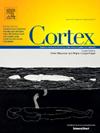7- 9岁儿童语义和句法自助的神经认知发展
IF 3.3
2区 心理学
Q1 BEHAVIORAL SCIENCES
引用次数: 0
摘要
我们研究了7- 10.5岁儿童的大脑和行为的纵向关系,以评估语义和句法语言的自我提升。这项研究是我们早期对5至7岁儿童的调查的直接延伸(Wagley & Booth, 2021)。在一系列的预注册和探索性分析中,我们测试了语义和句法知识如何影响与这些过程相关的左半球大脑区域的发展,即额下回小叶部(IFGop)和三角部(IFGtri)、颞后上回(pSTG)和颞后中回(pMTG)。我们还测试了这些大脑区域的参与如何影响儿童语义和句法知识的发展。受试者在数据收集时间1时年龄为7-8.5岁,时间2时年龄为9-10.5岁。层次回归分析包括N = 53名语义任务参与者和N = 41名语法任务参与者的数据,控制基线效应。与我们之前的研究一致,我们发现早期的行为可以预测后来的大脑活动,但早期的大脑活动并不能预测后来的行为。在整个分析中,pSTG中语义引导的证据很弱,但IFGtri中句法引导的证据很强。我们观察到在IFGop或pMTG中不支持语义或句法引导。这些结果补充了先前的语言行为模型,这些模型表明小学年龄较大的儿童词汇和语法发展之间存在密切关系,以及强调语义和句法整合对语言理解的重要性的神经认知模型。本文章由计算机程序翻译,如有差异,请以英文原文为准。
Neuro-cognitive development of semantic and syntactic bootstrapping in 7- to 9-year-old children
We examined longitudinal relations of brain and behavior assessing semantic and syntactic language bootstrapping in children from ages 7- to 10.5-years-old. This study is a direct extension of our earlier investigation on 5- to -7-year-old children (Wagley & Booth, 2021). In a series of preregistered and exploratory analyses, we tested how semantic and syntactic knowledge may influence the development of left hemisphere brain regions implicated in these processes, i.e., inferior frontal gyrus pars opercularis (IFGop) and pars triangulairs (IFGtri), posterior superior temporal gyrus (pSTG), and posterior middle temporal gyrus (pMTG). We also tested how engagement of these brain regions may influence the development of children’s semantic and syntactic knowledge. Participants were 7–8.5 years old at Time 1 and 9–10.5 years old at Time 2 of data collection. Hierarchical regression analyses included data from N = 53 participants for the semantic task and N = 41 for the syntax task, controlling for baseline effects. In line with our previous study, we found that early behavior predicted later brain activation but that earlier brain activation did not predict later behavior. Across the analyses, there was weak evidence of semantic bootstrapping in the pSTG but strong evidence in support of syntactic bootstrapping in the IFGtri. We observed no support of either semantic or syntactic bootstrapping in IFGop or pMTG. These results complement prior behavioral models of language suggesting close relations between lexical and grammatical development in older elementary school age children, as well as neurocognitive models that highlight the importance of semantic and syntactic integration for language comprehension.
求助全文
通过发布文献求助,成功后即可免费获取论文全文。
去求助
来源期刊

Cortex
医学-行为科学
CiteScore
7.00
自引率
5.60%
发文量
250
审稿时长
74 days
期刊介绍:
CORTEX is an international journal devoted to the study of cognition and of the relationship between the nervous system and mental processes, particularly as these are reflected in the behaviour of patients with acquired brain lesions, normal volunteers, children with typical and atypical development, and in the activation of brain regions and systems as recorded by functional neuroimaging techniques. It was founded in 1964 by Ennio De Renzi.
 求助内容:
求助内容: 应助结果提醒方式:
应助结果提醒方式:


